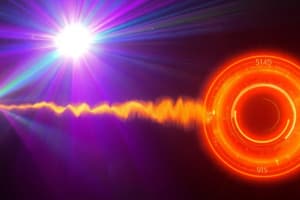Podcast
Questions and Answers
A satellite is a ______ station that receives and transmits signals.
A satellite is a ______ station that receives and transmits signals.
relay
Types of communication satellites include Geostationary, Medium-Earth, and ______ satellites.
Types of communication satellites include Geostationary, Medium-Earth, and ______ satellites.
Low-Earth
Communication satellites are used for applications like television and ______ distance telephone.
Communication satellites are used for applications like television and ______ distance telephone.
long
Geostationary Orbit Satellites are abbreviated as ______.
Geostationary Orbit Satellites are abbreviated as ______.
The book 'Computer Networking: A Top Down Approach' is authored by Jim Kurose and ______ Ross.
The book 'Computer Networking: A Top Down Approach' is authored by Jim Kurose and ______ Ross.
Study Notes
Electromagnetic Spectrum and Frequencies
- Ultraviolet light, X-rays, and gamma rays have higher frequencies but are challenging to produce, modulate, and are harmful to living organisms.
- The ITU nomenclature classifies frequencies: LF (Low Frequency) from 30 kHz to 300 kHz, MF (Medium Frequency), and HF (High Frequency).
- Bands above 10 MHz are categorized as Very, Ultra, Super, Extremely, and Tremendously High Frequency; additional terms include Incredibly, Astonishingly, and Prodigiously High Frequency (IHF, AHF, PHF).
Signal Information and Fiber Optics
- The capacity of electromagnetic waves to carry information is linked to both received power and bandwidth, making fiber optics favorable for networking due to their high bandwidth capabilities.
Radio Transmission
- Radio waves are easily generated, travel long distances, penetrate buildings, and transmit omnidirectionally, eliminating the need for precise alignment between transmitter and receiver.
- VLF, LF, and MF bands allow radio waves to follow the earth's contours, with effective detection possible up to 1000 km at lower frequencies; commonly used in AM radio broadcasting.
HF and VHF Bands
- In HF and VHF bands, ground waves are absorbed, but waves reaching the ionosphere reflect back to Earth, enhancing communication range.
Microwave Transmission
- Microwaves, operating above 100 MHz, travel in straight lines and can be focused using parabolic antennas which increase the signal-to-noise ratio.
- Effective communication requires precise alignment of transmitting and receiving antennas, allowing multiple transmitters to communicate with multiple receivers without interference when spacing is managed.
Need for Repeaters in Microwaves
- Due to the straight-line path of microwaves, repeaters are necessary for long distances; the spacing between repeaters can increase with tower height (e.g., 100-meter towers can be spaced 80 km apart).
Microwave Characteristics and Applications
- Microwaves range from 1 GHz (30 cm) to 12 GHz (1 mm) and are categorized into bands such as L, S, C, and X.
- Common uses include satellite communications, cellular networks, Bluetooth, Wi-Fi, and GPS.
- Microwave propagation can face challenges due to obstacles and atmospheric conditions, leading to multipath fading where delayed waves arrive out of phase, potentially canceling signals.
Water Absorption of Microwaves
- At frequencies around 4 GHz, microwaves are absorbed by water, particularly during rainfall, which may necessitate rerouting communication links to avoid interruptions.
Light Transmission
- Unguided optical signaling has historical applications and modern uses include connecting Local Area Networks (LANs) through rooftop lasers.
- Laser-based signaling is unidirectional, necessitating separate lasers and photodetectors at each end, offering high bandwidth and security.
Communication Satellites
- Satellites act as relay stations, receiving signals on one frequency, amplifying them, and retransmitting on another; they are classified based on orbital altitude:
- Geostationary Orbit Satellites (GEO)
- Medium-Earth Orbit Satellites (MEO)
- Low-Earth Orbit Satellites (LEO)
- Applications of satellites include television broadcasting, long-distance telephony, and private business networks.
Studying That Suits You
Use AI to generate personalized quizzes and flashcards to suit your learning preferences.
Related Documents
Description
Explore the fundamentals of the electromagnetic spectrum, with a focus on ultraviolet light, X-rays, and gamma rays. This quiz covers the properties, frequency ranges, and implications of various bands, as defined by the International Telecommunication Union. Test your knowledge on this crucial topic in physics!




